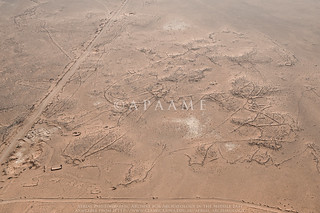In 2012,
David Kennedy’s ‘Pioneers above Jordan’ article acknowledged the contribution to aerial archaeology by Royal Air Force pilots flying on the Cairo-Baghdad Airmail Route. The individuals who published the first photographs of a site they had termed ‘Kites’ were Percy Eric Maitland (1895-1985), Lionel Wilmont Brabazon Rees (1884-1955) and Gilbert Stuart Martin Insall (1894-1972).
 |
| Maitland 1927 The 'Works of the Old Men' in Arabia, Antiquity 1 (2): plate III. |
Maitland’s article in the second issue of the new Journal Antiquity introduced the wider world to the concept of the ‘Works of the Old Men’ using aerial photographs taken by the RAF during passes of the Cairo-Baghdad air mail route. On Plate III a most striking Kite is presented as ‘Walls and Fort in Basalt Country’ –
this has been located as ‘Wisad Kite 40’ at 31°52'43.54"N, 37°55'59.01"E and can be clearly seen on Bing Maps despite the encroaching sands over the low basalt walls of the Kite. From the collection of aerial photographs taken back to the UK by O.G.S. Crawford (now housed in UCL Special Collections for the Institute of Archaeology) we know this photograph is actually a mosaic of a series of vertical photographs taken over the kite.
 |
| Wisad Wall Tangle 2: APAAME_20091004_DLK-0045. Photographer: David Kennedy. |
The other photograph on the plate, ‘Walls and Enclosures in Basalt Country’ may picture part of a kite amongst a tangle of walls – but the complex is now interrupted by a road and the El-Wisad Desert Patrol Post so we cannot quite clarify what the principle structure may once have been. We have identified the site as ‘Wisad Wall Tangle 2’:
31°53'6.82"N, 37°57'17.33"E.
Rees published photographs and images of a few Kites in
his article ‘The Transjordan Desert’, also in Antiquity, but later in 1929.
In ‘Circles Etc. in the Basalt Country South-West of Azrak’ on Plate
III you can see the kite located at 31°47'54.56"N, 36°43'15.56"E, which
we have photographed as ‘Amra Kite 4’.
 |
| Rees 1929 The Transjordan Desert, Antiquity 3 (12): plate IV. |
On Plate IV he shows a photograph of ‘Kites south of Kasr Azrak’ which is a well defined chain of Kites at 31°51'51.57"N, 36°48'46.89"E with Azraq Kite 46 the most prominent in the photograph,
but today the Kites are almost destroyed beneath increased farming and development around Azraq.
 |
| Azraq Kite 46 in 2012 with a newly planted olive grove across the site. APAAME_20120522_DLK-0607. Photographer: David Kennedy. |
In Plate VI he identifies a ‘Large Round Enclosure’ and two Kites on the photograph ‘Kazr Azrak and Surroundings’ but the ‘Large Round Enclosure’ is now entirely buried beneath the modern town (
see Kennedy’s Big Circles article for information regarding this kind of feature), and one Kite, approximately 31°53'29.01"N, 36°50'5.39"E, is buried beneath the modern road,
but the other is visible still at 31°53'39.43"N, 36°49'46.18"E. The photograph of ‘“Tell A”, near Landing-ground E’ on plate IX identifies several kites in the vicinity of the basalt mesa which can still be clearly seen from the air at 31°48'18.46"N, 37°25'59.97"E,
and have been photographed and visited by the project several times.
 |
| Original RAF image from Insall (1929 The Aeroplane in Archaeology, Journal of the Royal Air Force College, Cranwell 9.2: between pages 174-175) juxtaposed with the modern imagery from Google Earth. Composed by Travis Hearn. |
Also published in 1929 but less well known was Insall’s ‘The Aeroplane in Archaeology’ in the
Journal of the Royal Air Force College, Cranwell (9.2: 174-175). The well defined kite with three tails he published eluded us for quite some time, but a review of the basalt region recently conducted identified the Kite at
31°47'51.06"N, 37°33'46.61"E alongside another Kite. Crossing the tails in the background can be seen the old bulldozed track laid out through the desert by the ground parties creating the new airmail route that acted as a guide for the pilots. More prominent now in the satellite imagery is a track bulldozed through the head.






No comments:
Post a Comment
Note: only a member of this blog may post a comment.